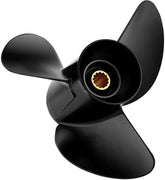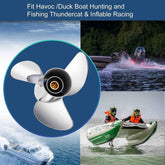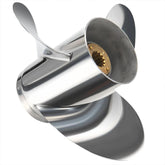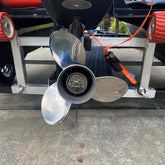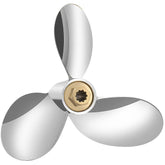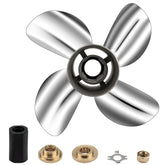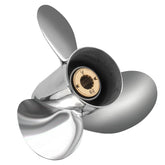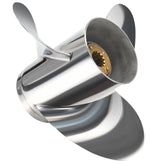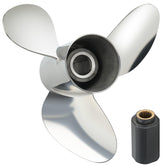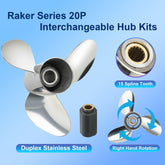How to Optimize Your Boat's Performance
When it comes to boat performance, every detail counts — from engine specifications to hull design, and of course, the propeller. One of the most critical, yet often overlooked aspects of boating performance is propeller slip. If you’ve ever wondered why your boat isn't achieving the advertised speed or efficiency, or if you notice a discrepancy between the engine’s RPM and the boat’s actual speed, propeller slip could be the culprit. In this guide, we’ll break down what propeller slip is, how to calculate it, and most importantly, how to reduce it to enhance your boat's performance.
Understanding propeller slip is not only important for optimizing speed and fuel efficiency but also for ensuring your boat’s longevity. Whether you’re running a Mercury outboard, Yamaha, or Honda, having the right propeller for your setup is essential for minimizing slip and maximizing performance.
Before diving into the details, if you’re looking for high-quality replacement propellers or upgrades, be sure to check out the Boat Propeller Online Store, offering options for top brands like Yamaha, Mercury, Honda, and more.
What Is Propeller Slip?
In simple terms, propeller slip refers to the difference between the theoretical distance a propeller should travel per revolution (based on its pitch) and the actual distance it travels through the water. Ideally, the propeller should push the boat forward exactly as much as its pitch suggests — for example, a 19-inch pitch propeller should move the boat forward 19 inches for every revolution. However, due to factors like water resistance, engine load, and design characteristics, propellers often slip, resulting in less movement per revolution than expected.
While propeller slip is an unavoidable aspect of boating, the goal is to keep it within a reasonable range. A certain amount of slip is normal, but excessive slip can lead to wasted engine power, reduced speed, and poorer fuel efficiency. High slip numbers indicate that the engine isn’t achieving its potential power output, which could mean the wrong propeller is being used or the engine is struggling to operate at its peak efficiency.
How to Calculate Propeller Slip
To accurately calculate propeller slip, you'll need two key pieces of data:
-
Theoretical speed: This is the speed the boat would achieve if the propeller didn’t slip at all. It can be calculated using the pitch of the propeller and the RPM of the engine.
The formula to calculate theoretical speed is:
Theoretical Speed (mph)=12 inches per foot×5280 feet per milePitch (inches)×RPM×60 -
Actual speed: This is the real-world speed the boat is achieving as measured on the water with a GPS or speedometer.
Once you have both values, you can use the following formula to calculate propeller slip:
Slip (%)=Theoretical SpeedTheoretical Speed−Actual Speed×100
For example, if your boat is running at 25 mph but the theoretical speed suggests it should be doing 30 mph at the same RPM, the slip would be:
3030−25×100=16.67%
This means the propeller is slipping by around 16.67% — more than the typical range for many setups, suggesting an issue with the current propeller selection.
Factors Affecting Propeller Slip
There are several factors that contribute to propeller slip, and understanding them is crucial for choosing the right propeller and maintaining optimal performance. Let’s take a look at the main causes:
1. Propeller Pitch
The pitch of a propeller directly influences how much slip occurs. A higher-pitch propeller will typically have more slip at lower RPMs but may offer better top-end performance. Conversely, a lower-pitch propeller can help reduce slip at lower speeds but may limit top-end speed. Choosing the right pitch is crucial for reducing slip while still meeting your performance goals.
If you find that your boat is slipping excessively, you might want to consider changing the pitch of your propeller. For example, switching from a 19-inch pitch prop to a 17-inch pitch prop might reduce slip and improve acceleration, especially on heavier boats or those with larger loads. Explore the selection of propellers for Mercury to see how pitch affects slip for different types of boats and engine setups.
2. Boat Load and Weight
The weight of your boat — including passengers, gear, and equipment — can significantly affect propeller slip. When you load your boat with extra weight, the propeller has to work harder to move it through the water. This increases the likelihood of slip, especially with lighter or underpowered boats. To reduce slip, it’s essential to account for the boat’s load and adjust the propeller accordingly.
Boats that carry multiple passengers, such as pontoon boats, or those frequently towing water sports equipment, will often need a propeller with more blades or a lower pitch to minimize slip and maximize performance.
3. Water Conditions
Water density plays a big role in propeller slip. For instance, freshwater is less dense than saltwater, meaning a propeller may slip more in freshwater than it would in saltwater due to lower resistance. On top of that, choppy or rough water conditions can cause additional turbulence around the propeller blades, increasing slip.
In saltwater conditions, boats often require stronger, more durable stainless steel propellers to withstand corrosion, and also to perform optimally despite the higher density of the water. Explore stainless steel propellers for Yamaha and other brands for a prop that will handle demanding conditions while reducing slip.
4. Engine Setup and Trim
The angle at which the propeller is operating in the water — the trim — can influence how much slip occurs. A boat’s engine height and trim adjustment can reduce or increase the amount of slip. If the engine is too high or too low relative to the waterline, the propeller may slip more than expected.
To reduce slip, ensure the engine is properly trimmed, and if necessary, adjust the mounting height or angle of your engine. Keeping the boat at the proper trim angle ensures that the propeller remains fully submerged and operates at peak efficiency.
How to Reduce Propeller Slip
Now that you understand the factors contributing to propeller slip, let’s look at practical steps you can take to reduce it.
1. Select the Right Pitch
As mentioned earlier, adjusting the pitch of your propeller can directly impact slip. If your boat is slipping more than you’d like, consider a propeller with a lower pitch, as this will reduce the load on your engine and help it maintain RPMs without slipping. On the flip side, a higher pitch is great for top speed but may result in higher slip at lower speeds.
If you’re unsure about which propeller pitch is right for your boat, explore the propeller selection tool for Mercury, which can help you choose the optimal pitch based on your boat type, engine, and typical usage conditions.
2. Upgrade to a Higher-Quality Propeller
If you’re currently using an aluminum propeller, upgrading to a stainless steel prop can help reduce slip due to its greater rigidity and durability. Stainless steel propellers are better at maintaining their shape under high stress, resulting in less flex and more efficient power transfer from the engine to the water.
You can find top-quality stainless steel propellers for Yamaha and Mercury that help reduce slip and improve fuel efficiency.
3. Proper Engine Trim
Ensuring that your engine is properly trimmed and mounted at the right height can reduce the angle at which your propeller cuts through the water, thereby reducing slip. A well-trimmed boat will allow the propeller to run efficiently, especially at higher speeds.
Final Thoughts: Minimizing Slip for Maximum Efficiency
Propeller slip may be an unavoidable reality in boating, but understanding it is the first step in achieving better performance. By calculating slip, identifying the root causes, and making the right adjustments to your propeller and engine setup, you can reduce the amount of wasted power and ensure that your boat runs at its full potential.
If you’re looking to optimize your setup, be sure to explore the full range of propellers for Suzuki, Honda, and Volvo to find the perfect match for your boat. Reducing propeller slip is a simple but highly effective way to get more out of your boating experience — from top-end speed to better fuel economy and less engine wear.
For more information on how to choose, maintain, and optimize your propellers, don’t forget to check out our resources on how propellers are manufactured and other essential boating topics.


